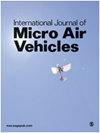在风洞中对机翼进行各种迎角的测试
IF 1.5
4区 工程技术
Q2 ENGINEERING, AEROSPACE
引用次数: 2
摘要
尾座飞机具有复杂的空气动力学特性,使其在整个飞行包线中难以控制,特别是在非常大的迎角(AoA)和逆流条件下。由于缺乏在这种条件下所经历的力和力矩的公开数据,这些车辆的控制器的开发受到阻碍。在所有可能的AoA下,在不同的襟翼偏转和油门设置下进行了风洞实验。数据集是开放获取的。我们对测试机翼的数据分析显示,襟翼偏转对升力系数的影响很大,在±15°AoA和±160°时都会发生失速。通过分析与推力轴正交轴上螺旋桨诱导力的非线性耦合关系,研究了翼-螺旋桨相互作用。文中还讨论了反流对机翼的影响:数据证实,当机翼上的气流反向时,襟翼偏转对俯仰力矩的影响与非反向情况相反,但这种相反的影响可以通过增加油门设置来避免。数据显示了在这种情况下襟翼挠度和力之间的确切关系。此外,研究发现,有或没有旋转螺旋桨的机翼在0°AoA左右的襟翼控制效果通常比在±180°时要高,从0°到±18.91°的襟翼控制效果比从±18.91°到各自的±37.82°的襟翼控制效果更好。本文章由计算机程序翻译,如有差异,请以英文原文为准。
Wind tunnel tests of a wing at all angles of attack
Tailsitters have complex aerodynamics that make them hard to control throughout the entire flight envelope, especially at very high angle of attack (AoA) and reverse flow conditions. The development of controllers for these vehicles is hampered by the absence of publicly available data on forces and moments experienced in such conditions. In this paper, wind tunnel experiments are performed under different flap deflections and throttle settings at all possible AoA. The dataset is made open access. Our analysis of the data shows for the tested wing, flap deflections greatly affect the lift coefficient and stall occurs at ± 15 ∘ AoA as well as ± 160 ∘ . Wing-propeller interaction is studied by analyzing the propeller induced force in the axis orthogonal to the thrust axis, which is dependent on AoA, airspeed, flap deflections and thrust in a nonlinear and coupled manner. The influence of inverse flow on the wing is also discussed: The data confirm that when the airflow over the wing is reversed, flap deflections will affect the pitch moment in an opposite way compared to the non-reversed case, but this opposite effect can be avoided by increasing the throttle setting. The data show the exact relationship between flap deflections and forces in this condition. Moreover, it is found that the flap control effectiveness for a wing with or without spinning propellers is usually higher around zero degrees AoA than at ± 180 ∘ and it is more effective to change the flaps from 0 ∘ to ± 18.91 ∘ than from ± 18.91 ∘ to the respective ± 37.82 ∘ .
求助全文
通过发布文献求助,成功后即可免费获取论文全文。
去求助
来源期刊

International Journal of Micro Air Vehicles
ENGINEERING, AEROSPACE-
CiteScore
3.00
自引率
7.10%
发文量
13
审稿时长
>12 weeks
期刊介绍:
The role of the International Journal of Micro Air Vehicles is to provide the scientific and engineering community with a peer-reviewed open access journal dedicated to publishing high-quality technical articles summarizing both fundamental and applied research in the area of micro air vehicles.
 求助内容:
求助内容: 应助结果提醒方式:
应助结果提醒方式:


